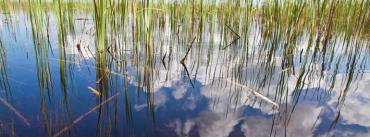
It's unfathomable to me that the Everglades Foundation can continue to claim “hypersalinity” is killing seagrass in Florida Bay -- proposing to “send water south” from Lake Okeechobee to save the bay.
On Saturday, Eric Eikenberg, the Foundation's CEO, issued a press statement saying just that:
"Drawing upon several decades of Everglades science experience and utilizing sophisticated mathematical modeling tools (the same tools used by the State of Florida)," he wrote, "Everglades Foundation scientists have concluded that this problem can be prevented. The solution: storing significant water south of Lake Okeechobee. This would provide for the freshwater needs of Florida Bay while reducing harmful discharges to the east and west. Three estuaries, one solution."
 How many times does Eikenberg have to hear from scientists working in the field -- really working for decades studying the decline of coral reefs, for example -- that the "science" he's peddling doesn't hold water (pun intended) -- particularly for Florida Bay?
How many times does Eikenberg have to hear from scientists working in the field -- really working for decades studying the decline of coral reefs, for example -- that the "science" he's peddling doesn't hold water (pun intended) -- particularly for Florida Bay?
The Foundation's hypothesis belongs in mothballs. It's been around for decades. It was demonstrated to be fatally flawed in the early 1990s when the newly formed Florida Keys National Marine Sanctuary (FKNMS) was established to “protect water quality” in Florida Bay and the Florida Keys.
Allow me to summarize:
After FKNMS officials demanded more fresh water, water flows were ramped up to both Shark River Slough and Taylor Slough, bringing more freshwater to Florida Bay -- and the salinity dropped. What happened? The Everglades Foundation knows but it doesn't say: Rather than improving water quality, massive blue-green algae blooms, similar to those currently impacting the St. Lucie and Caloosahatchee estuaries, formed in Florida Bay and were carried by currents through the tidal channels of the Keys, all the way to sensitive offshore coral reefs.

Not only did this trigger more seagrass die-off in the bay by reducing much-needed light, but also a sponge die-off, and a plethora of coral diseases in the “Marine Sanctuary” that reduced living coral cover by some 40 percent between 1996 and 2000.
And, because of all the septic tanks and sewage discharging into Keys coastal waters, the reduced salinity and regional algae blooms triggered a proliferation of fecal bacteria that closed area beaches -- all the way from Key Largo to Key West. Yes, the beaches were closed, just like this past week in Martin County.
The problem was, the Bay needed clean water, not just fresh water. The nitrogen in the dirty fresh water stimulated the blue-green algae blooms in Florida Bay, and the regional water quality has not been the same since. This is not Nancy Smith talking, it comes from the work of scientists who have been, and are now, actively studying coral reef decline and water quality.
The once “gin clear” water in the Keys is now “emerald green,” and average visibility has decreased from 70 feet or more in the 1980s to less than 20 feet these days.
The hypersalinity "hypoorthesis" was never supported by science, much less common sense, and was officially de-bunked by the National Academy of Sciences over a decade ago.
And, the idea of cleaning nitrogen from millions of acre-feet of water a year before it gets to Florida Bay? That is a pipe dream that even the tooth fairy wouldn’t promise. Again, please don't take that from me. Ask any scientist without an ax to grind, who is versed in this discipline. Cleaning water of phosphorous is one thing; trying to remove nitrogen is quite another.
Actually, investigative reporters Bob Malloy and Will Bourne wrote about all this in 1996 -- about how money and political influence contributed to the demise of water quality and the seagrass/coral reef ecosystems of Florida Bay and the Florida Keys. The story records the cluster of misery left in the wake of scientists -- the very scientists who form the Everglades Foundation's opinions today -- whose theories were disastrously off base.
Everglades Foundation founders George Barley and Paul Tudor Jones featured large in the 7,925-word epic. According to the story, Barley bought into bad science promulgated by Joseph Zieman, a University of Virginia seagrass biologist, and his colleague, Ron Jones of Miami's Florida International University; Tudor Jones bankrolled the development of their wrong conclusions. Meanwhile, water quality in Florida Bay and the upper Keys worsened because of it.
An ecological disaster had been unfolding in South Florida since the 1970s. "Fishermen began reporting blooms of sheetlike macroalgae in western Florida Bay, the crescent of water that lies between the Keys and the southern tip of the mainland," wrote the authors.
Much of the coral in the Keys died between 1986 and 1996. Said Malloy and Bourne, "These algae blooms today are as bad as they have ever been. ... An estimated 100,000 acres of seagrass has died while schools of tarpon and other game fish are washing up onto the beaches, killed by explosive blooms of neuro-toxic 'red tide.'"
Zieman sold the scientific community and prevailing bureaucrats his theory, that a reduction in the freshwater flow through the Everglades had led to a chronic increase in the salinity of Florida Bay. Too much salt in the water was somehow killing seagrass beds.
Eventually, Zieman and Jones, the purveyors of bad science, were "disappeared." Zieman, at least for a time, did leave the state. And Jones not only left Florida, he left his tenured professorship at FIU and all of his funding.
That's not to say the environmental community ever acknowledged their devastating mistake -- frightening in the context of the Everglades Foundation/Trust/Coalition today. They bought into it so far, they couldn't afford to drop it. Instead, they relate all the failure to "climate change."
Wrote Malloy and Bourne, "What began for us as an investigation of bad science, of a flawed hypothesis that seemed to acquire supernatural powers, evolved into an examination of power, money and big-business environmentalism in South Florida. As environmentalists, it rapidly soured us on the philosophy and tactics that have moved to the forefront of the battle to save our natural treasures. It became a case study in ethical disintegration."
Remember, Malloy and Bourne wrote this 20 years ago. Other scientists, even before the National Academy of Sciences debunked hypersalinity, called it "bad science." Now even NOAA looks at its dying coral reefs and can't explain it.
And by the way: Here's what Catherine Elizabeth Barley-Albertini, daughter of Everglades Foundation founder George Barley, wrote in Facebook June 21: "If everyone would have listened to Brian Lapointe of Harbor Branch Oceanographic Institute, Florida Bay and the Indian River Lagoon would have had a chance to have been saved already. Instead, bad science and covert agendas prevailed. I think my late-father, George Barley was duped, and would have eventually changed his mind on cause should he have survived, because he was always skeptical and questioned everything."
Lapointe is one of the working marine biologists who tries to open the curtain and reveal the truth about the Foundation-FKNMS bogus hypothesis.
I write about this every once in a while. It's a story to keep in mind as the Everglades Foundation continues to peddle claims it knows how to control algae and make Florida Bay better.
Shouldn't Florida, perhaps the University of Florida, convene a gathering of real scientists with knowledge and studies performed in and of coastal waters, to discuss this publicly? Don't we need to make sure we're going in the right direction, or do we really want to continue taking the Everglades Foundation's word for it?
Reach Nancy Smith at nsmith@sunshinestatenews.com or at 228-282-2423. Twitter: @NancyLBSmith


